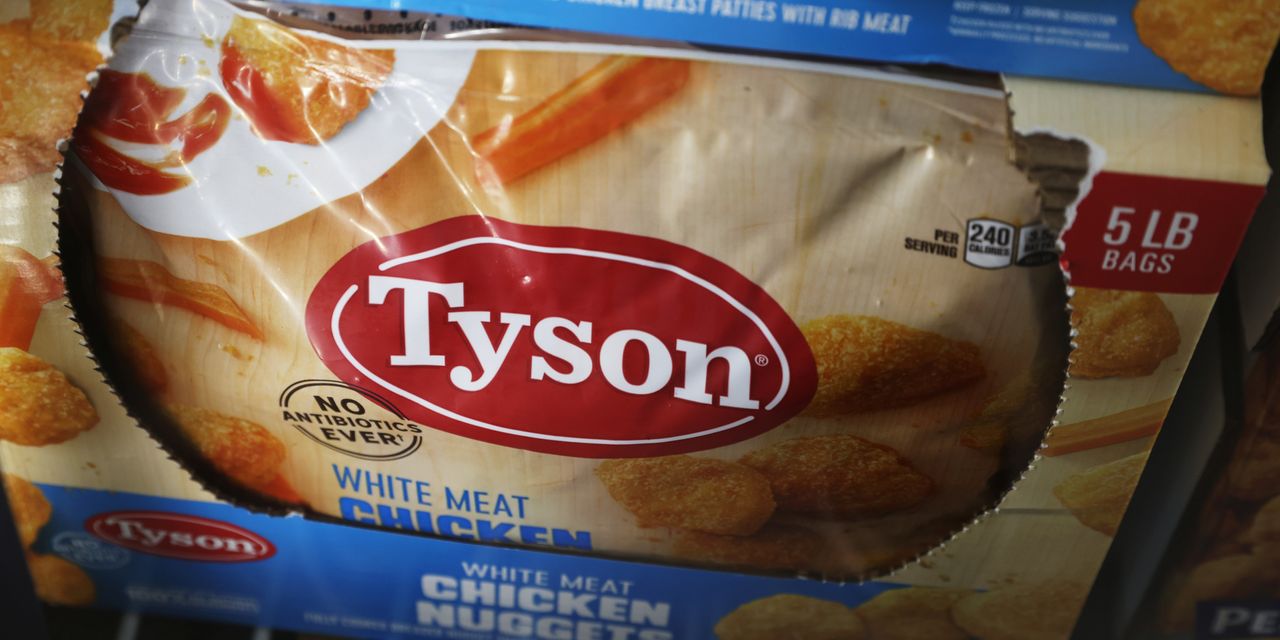
Escalating meat prices haven’t slowed restaurant and retailer demand for meat, Tyson Foods Inc. TSN 12.23% executives said, as rising prices helped to more than double the company’s quarterly profit.
Tyson, the biggest U.S. meat processor by sales, said that orders for beef, chicken and pork continue to outpace its ability to supply products, with its plants still short on workers. Raising wages and expanding benefits to recruit and retain staff is helping drive meat prices higher, Tyson said, along with transportation and other costs.
Over the three months ended Jan. 1, Tyson said its average beef prices rose by nearly one-third compared with the same period a year earlier, while pork prices increased by 13% and chicken by about 20%.
“We’re seeing inflation across our supply chain,” Chief Executive Officer Donnie King said on a call with reporters.
Tyson and other U.S. meatpackers are under pressure to keep up with surging demand from supermarkets and reopening restaurants. A nationwide labor shortage has left many processing plants understaffed and unable to keep up, leading to higher prices and shortages of some products, industry officials have said.
The Arkansas-based company said it raised prices across its business units in its fiscal first quarter as its cost of goods sold increased 18% from a year ago. Freight costs rose 32%, the company said, and rising wages and additional employee benefit programs to improve staffing, such as subsidizing child care, pushed labor costs up 20%.
Inflation throughout the supply chain is leading to higher prices for many products and services in a variety of industries, especially food. U.S. inflation hit its fastest pace in nearly four decades last year. Rising food prices are leading some consumers to seek out cheaper groceries and discounts, supermarket operators have said, with some shoppers buying more store-brand meat products and trading down from beef to less-expensive alternatives such as chicken or pork.
Despite higher prices, consumer demand for its products has stayed strong, Tyson executives said.
“We’re not asking customers or the consumer ultimately to pay for our inefficiencies, we’re asking them to pay for inflation,” said Mr. King, a three-decade veteran of the company who took over as Tyson’s CEO in the summer of last year. “The rest of what we do is we try to find ways to be more productive.”
The meat processor said its net income for the quarter rose to $1.12 billion from $467 million a year ago, propelled by higher profit margins in its beef, pork and chicken divisions. Tyson’s quarterly sales grew 24% from a year ago to $12.93 billion. The results surpassed Wall Street expectations, and Tyson forecast continued strength in its operations. Shares jumped 12% in midday trading Monday.
Despite continuing labor shortages in its meat plants, Tyson said it has largely moved past the recent surge of Covid-19 infections from the Omicron variant that stretched workforces from processing plants to grocery stores.
“We’re back to normal levels,” said Mr. King. “We think our vaccine mandates served us well.”
Tyson said it plans to spend about $2 billion mainly focused on increasing production capacity and automation capabilities in its plants in its 2022 fiscal year. Covid-19 infections among meat-plant workers have deepened the U.S. meat industry’s long-running difficulties keeping plants fully staffed, leading meatpackers like Tyson to increase investments in automation.
Operating income margins in Tyson’s beef business grew to 19% in the most recent quarter, compared with 13% in the same period a year ago. Sales volumes in beef declined about 6% as the company struggled to staff its plants to keep up with higher demand, company officials said.
Tyson’s chicken business margins over the quarter improved to about 4% from being negative a year earlier, and sales increased 37% to $3.9 billion for the quarter. The top U.S. chicken company said it expects higher chicken volumes in 2022 as it focuses on running its plants more efficiently, and hatching rates improve among chicks to be shipped to farms.
The meat industry’s rising profit margins have drawn the ire of the White House. In January, the Biden administration outlined tighter regulations for U.S. meatpackers, accusing the industry of using its scale to inflate Americans’ food bills. The steps outlined range from funds for regional meat processors to help them better compete with big companies, to stricter rules for livestock purchasing and meat labeling, which are aimed at supporting U.S. farmers and ranchers.
Meat companies have said their results reflect market forces that have arisen from persistent supply chain problems and labor shortages, which have constrained meat production as the economy recovers from the pandemic.
“We firmly believe the market is the best at setting prices based on supply and demand fundamentals,” Shane Miller, Tyson’s head of beef and pork, said on a call with reporters.
Write to Patrick Thomas at [email protected]
Copyright ©2022 Dow Jones & Company, Inc. All Rights Reserved. 87990cbe856818d5eddac44c7b1cdeb8








